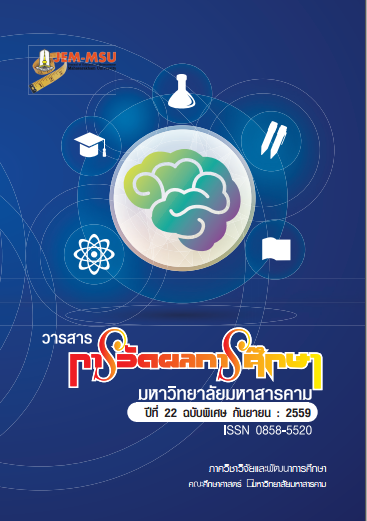A Development Of Knowledge Management Model For Schools in the Office Of Secondary Education Service Area 41
Main Article Content
Abstract
The purposes of this research were to investigate conditions and problems of
knowledge management, generate type, and evaluate use of knowledge management model
for schools under Secondary Educational Service Area Office 41. The study was divided into 3
steps as follows. The first one was to examine the conditions and problems of knowledge
management by using questionnaires to collect data from 339 administrators and teachers.
Then the data was analyzed by applying mean and standard deviation. The second step was to
create the type of knowledge management by conducting a connoisseurship with 11 experts
based on content analysis. The third step was to test the type of knowledge management
with a school to explore satisfaction and achievement of the use of model and type of
informant. The total 50 respondents consisted of 3 administrators, 42 teachers, and 5
educational personnel. Besides, the mean and the standard deviation were also applied to data
analysis.
The results were indicated below.
1. According to Secondary Educational Service Area Office 41, the overall
conditions of knowledge management model for schools under were at high level. When
considering each aspect, it found that knowledge acquisition was at the highest level,
followed by knowledge identification. However, the overall problems of knowledge
management of the schools were at low level. When considering each aspect, it
demonstrated that knowledge implementation was at the lowest level. It could be said
that the knowledge management of every school was at high level while there were less
problems. Therefore, the personnel of these schools could be able to manage the
knowledge.
2. Regarding to the knowledge management under Secondary Educational Service
Area Office 41, there were 5 elements as described below; 1) Background and rationale, 2)
Concept of model, 3) Objective of model, 4) Process of model Moreover, the process of
knowledge management included 3 stages as follows. The first one was planning which
applied 5 indicators and 4 practices. The second one was the operation of knowledge
management comprising of 6 elements – Knowledge identification with 5 indicators and 7
practices, knowledge acquisition with 6 indicators and 8 practices, knowledge creation with 7
indicators and 9 practices, knowledge exchange with 6 indicators and 9 practices, knowledge
storage with 4 indicators and 9 practices, as well as knowledge implementation with 8
indicators and 10 practices, and 5) Expected results which contained the third stage - monitoring/
follow-up/evaluation with 4 indicators and 5 practices.
3. Most of the executives, teachers, and educational personnel of the schools
that applied the type of knowledge management under Secondary Educational Service Area
Office 41 were satisfied and able to successfully implement the type of knowledge
management at high level.
Article Details
The content and information contained in the published article in the Journal of Educational Measurement Mahasarakham University represent the opinions and responsibilities of the authors directly. The editorial board of the journal is not necessarily in agreement with or responsible for any of the content.
The articles, data, content, images, etc. that have been published in the Journal of Educational Measurement Mahasarakham University are copyrighted by the journal. If any individual or organization wishes to reproduce or perform any actions involving the entirety or any part of the content, they must obtain written permission from the Journal of Educational Measurement Mahasarakham University.


